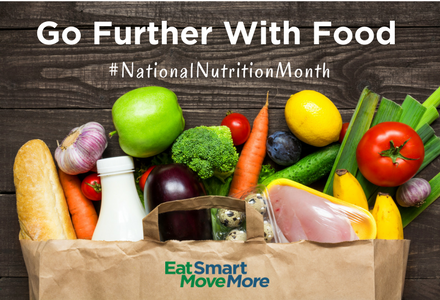March is National Nutrition Month, a yearly focus on eating smart promoted by the Academy of Nutrition and Dietetics, the professional association of Registered Dietitian Nutritionists. This year’s theme is Go Further with Food, emphasizing the way food fuels our lives, as well as relating to stretching food budgets and preventing food waste. This theme meshes well with the Family Nutrition Program’s mission to help our participants eat smart on a budget. Meal planning, my favorite topic, is key for going further with food. The Academy listed key messages to focus on this month and I’ve added some additional details (with links to previous posts!) on how you can go further with food this month and all year long.

Happy #NationalNutritionMonth! Check out these fun ways you can celebrate this March: https://sm.eatright.org/NNMtoolkit
- Include a variety of healthful foods from all of the food groups on a regular basis.
- Use MyPlate when planning meals to make sure you’re getting something from each food group.
- Eat a Rainbow to get a variety of vitamins and minerals from different colored fruits and vegetables. Visit your local farmers market to get fresh, locally grown fruits and veggies (and more!). Many farmers markets accept SNAP and some even offer SNAP matching programs to stretch your budget even further.
- Plant-based proteins, like nuts, seeds, beans, and peas, are great choices. They’re low-cost and full of nutrition, helping your budget go further while increasing nutrition.
- Whole grains and low-fat dairy are healthier choices than refined grains or full-fat dairy for about the same price. Slowly switch to whole grain and lower fat versions of you favorite grain and dairy foods to give your tastebuds time to adapt.
- Consider the foods you have on hand before buying more at the store.
- Shop your pantry first. This is one of the 7 steps for meal planning on a budget. You’ll save money and waste less food when you plan your menu around foods you already have on hand.
- Use up perishable foods first, then shelf-stable. When you write out your menu, put meals that use fresh produce earlier in the week. You’ll cook and eat those first, so they won’t wilt or spoil before you eat them. Later in the week, plan meals that have frozen or canned ingredients or produce that stores well, like root veggies or apples.
- Buy only the amount that can be eaten or frozen within a few days and plan ways to use leftovers later in the week.
- Buy a variety of fresh, frozen, canned, or dried fruits and vegetables. All are nutritious choices and can help reduce food waste.
- Shopping more frequently can help reduce food waste.
- Remember the 4 Day Throw Away rule. Find storage times on FoodSafety.gov’s website. For the more tech-savvy, USDA’s FoodKeeper App is a great tool for tracking how long to store different foods. You can even get notifications to use something before it goes bad.
- Learn how to freeze foods safely. The University of Georgia’s Home Food Preservation site is a great resource to use. Frozen meals can be a great time saver on busy nights.
- Learn how to repurpose small amounts of food. For example, when I get to the end of a bottle of mustard, I pour a little vinegar and olive oil in the bottle, shake it up and make a super quick salad dressing. Build Your Own recipes are another way to mix and match leftovers into easy meals without a set recipe.
- Be mindful of portion sizes. Eat and drink the amount that’s right for you, as MyPlate encourages us to do.
- Your hand makes a good portion estimation tool.
- Water is the best beverage choice when you’re thirsty. Make sure you’re drinking enough and try using reusable water bottles instead of bottled water to reduce plastic waste and save some money.
- Continue to use good food safety practices.
- As you work to reduce food waste and repurpose leftovers, be sure you’re following the 4 basic steps of food safety – Clean, Separate, Cook, and Chill.
If you missed our Facebook Live video chat earlier this afternoon, check it out here for even more information. How will you take steps to go further with food? Share your ideas in the comments!

